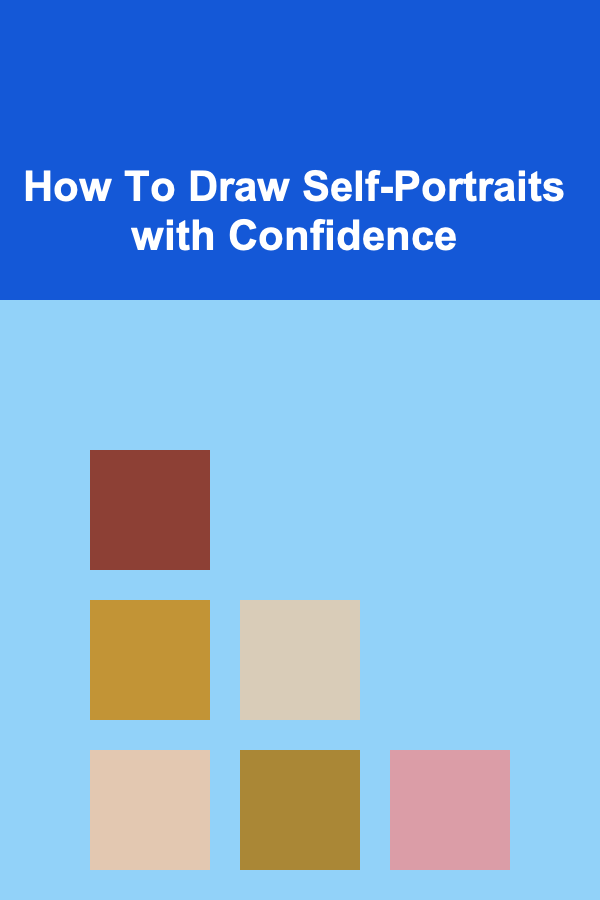
How To Draw Self-Portraits with Confidence
ebook include PDF & Audio bundle (Micro Guide)
$12.99$6.99
Limited Time Offer! Order within the next:

Drawing a self-portrait is an incredibly personal and introspective activity that connects you to both your creative spirit and your physical self. For many artists, creating a self-portrait is a way to express their inner world, an exploration of identity, and a means to gain deeper understanding of one's appearance. Despite its rich emotional significance, many individuals struggle with self-portraiture, often feeling uncertain or lacking in confidence when it comes to drawing their own likeness.
This article will guide you through the process of drawing self-portraits with confidence, offering practical steps and tips that encourage growth, experimentation, and, ultimately, mastery. By combining technical skills with emotional awareness, you can elevate your self-portraiture practice into a fulfilling and self-empowering experience.
Embrace the Introspection
Before picking up a pencil or brush, take a moment to understand the emotional significance of drawing your own portrait. Self-portraiture isn't just about replicating what you see in the mirror; it's a reflection of how you perceive yourself. What do you want to communicate through this drawing? Is it your mood, your age, a snapshot of a particular moment in time, or a more abstract representation of your feelings and thoughts?
The Power of Introspection
Taking the time to introspect before you begin will give you the emotional clarity you need to make the drawing process more meaningful. This can lead to a deeper connection with your work. Whether you choose to depict yourself realistically or in an abstract way, your self-portrait can become a visual diary, a profound representation of who you are in that moment.
Take inspiration from artists who have used self-portraiture to explore their emotions and identity. From Frida Kahlo's raw, intense self-portraits to Rembrandt's introspective and nuanced depictions, each artist approaches the process with a deep sense of personal expression. Your own self-portrait can be a unique canvas for you to express your individuality and your connection to your artwork.
Start with the Basics: Understanding Proportions
The key to drawing a convincing self-portrait lies in understanding the proportions of the human face and body. Even if you're not aiming for photorealism, an accurate foundation in basic proportions will give you a solid structure upon which to build.
The Structure of the Human Face
The human face is incredibly complex, but it follows a set of proportional rules that are essential to understand when drawing a portrait. Here are some key points to keep in mind:
- The Vertical Line: The face can be divided vertically into equal halves. This division helps to align the features symmetrically.
- The Horizontal Line: The eyes generally sit on a horizontal line halfway down the face. The space between the eyes is typically the width of one eye.
- The Nose and Mouth: The bottom of the nose is usually placed halfway between the eyes and the chin, while the mouth falls about a third of the way below the nose.
Learning to break down the face into these simple proportions will help you to draw with more precision, even if your style is more expressive or abstract.
Practice with Simple Shapes
Start by drawing simple shapes to represent the basic elements of the face. For instance:
- Draw an oval to represent the head.
- Add a line down the center to help align the facial features.
- Mark the horizontal lines for the eyes, nose, and mouth.
This method will act as a scaffold for your self-portrait. Once the basic structure is in place, you can refine it, adding the more nuanced details.
Study Your Own Features
One of the most challenging aspects of self-portraiture is accurately capturing your own likeness. Unlike drawing someone else, you can't rely on memory or a photograph; you must engage directly with your reflection or live model.
Using a Mirror vs. a Photograph
Some artists prefer to use a mirror when drawing self-portraits, as it allows them to observe their face in real time and respond to it as they draw. Others may choose a photograph to work from, which can provide a more controlled and less dynamic reference.
Each method has its advantages:
- Mirror Drawing: Working with a mirror lets you connect with your reflection in an intimate way, but it also can be challenging, especially in terms of spatial awareness and depth perception.
- Photograph Drawing: A photo allows for more accurate proportion and clarity, but it removes the dynamic interaction between the artist and their reflection.
Experiment with both methods to discover which one feels more comfortable to you. Many artists use a combination of the two, starting with a photograph and finishing with a mirror session for more intimate, real-time adjustments.
Observing Your Face
Take the time to study your features closely. Notice subtle details that make you unique---these could be facial expressions, the shape of your eyes, or how light falls across your face. Don't just focus on the obvious features, like your eyes and nose; consider the shapes and contours that define your face.
Ask yourself:
- What emotions are conveyed through my expression?
- How do my eyes interact with the rest of my face?
- What is the angle of light on my face?
These nuances will give your self-portrait a sense of depth and personality.
Experiment with Perspective
A key factor in creating a compelling self-portrait is the choice of perspective. You don't have to draw yourself straight-on or in a static pose. In fact, experimenting with different angles can add interest and complexity to your portrait.
Various Perspectives
- Straight-on View: This is the most straightforward approach, where you face the mirror directly. It's ideal for beginners, as it's easier to manage the proportions and angles.
- Three-Quarter View: Turning your head slightly creates a more dynamic pose, emphasizing depth and volume in the face. This view shows more of the side of your face and can create an intriguing interplay of light and shadow.
- Profile View: A side view of your face can emphasize the curve of your nose, the shape of your chin, and the contours of your neck. It can also provide a more dramatic effect.
Vary your angles with each self-portrait to challenge yourself and learn how to approach different perspectives. Try to embrace the discomfort of drawing from an unfamiliar viewpoint, as this can be a great opportunity for growth.
Develop Your Style
As you practice, you will naturally begin to develop your own approach to self-portraiture. Whether it's a realistic depiction or a more abstract representation, your style is a reflection of your creative voice.
Techniques to Explore
- Line Work: Experiment with bold, expressive line work that exaggerates certain features or emotions. You may want to use thick, dark lines to emphasize particular contours or a light, sketchy style to create a more ethereal portrait.
- Color: If you're using color, think about the palette that best reflects the mood or feeling you want to convey. Do you want to use warm tones to evoke warmth and comfort, or cool tones for a more introspective mood?
- Textures: Consider how different textures can add depth and emotion to your portrait. For example, rough textures can add intensity, while smooth textures create a sense of calmness.
Don't be afraid to experiment with different materials, such as charcoal, pastels, or digital tools. The process of developing your style can be one of the most rewarding aspects of drawing self-portraits.
Focus on Imperfection
Confidence in self-portraiture doesn't mean striving for perfect realism or flawless technique. In fact, embracing the imperfections in your artwork can make it more meaningful and authentic.
Embrace Your Unique Features
Every face has its quirks---small asymmetries, idiosyncratic expressions, or subtle details that make it distinctly yours. Instead of trying to "correct" these imperfections, celebrate them. Your self-portrait is not about achieving perfection but about portraying who you are at that moment in time.
As you gain experience, you may start to accept your artistic imperfections, recognizing them as part of your creative voice. These moments of imperfection often hold the most character and emotion.
Practice and Patience
Like any skill, drawing self-portraits takes time and practice. The more you draw, the more confident you will become in your ability to capture your likeness and express yourself through art.
Building a Routine
Create a routine for drawing self-portraits. Set aside time each week to engage with your reflection, and challenge yourself to explore new techniques, angles, and styles. Over time, you'll notice your skills improving, and your confidence will grow.
Reflect on Your Progress
Take time to reflect on your past self-portraits. What have you learned? What are you proud of? Don't be afraid to look at your earlier works and see how far you've come. This reflective practice will not only help you appreciate your progress but also encourage further growth.
Conclusion
Drawing self-portraits is an empowering journey that blends creativity with introspection. By embracing the process with patience, studying your features, experimenting with perspective, and developing your unique style, you can build confidence in your ability to express yourself through art. Don't be afraid of imperfections---after all, they are what make your self-portrait truly yours. Keep practicing, stay curious, and most importantly, enjoy the journey of self-expression that comes with each self-portrait you create.

How to Build a Checklist for Coordinating Book Club Social Events
Read More
How to Create Themed Weeks to Keep the Excitement Alive
Read More
How to Experience the Music and Culture of New Orleans
Read More
How to Prepare Healthy Breakfast Options for the Week
Read More
How to Use Vertical Space to Save Room in Every Room
Read More
How to Explore Electric Agricultural Vehicles
Read MoreOther Products

How to Build a Checklist for Coordinating Book Club Social Events
Read More
How to Create Themed Weeks to Keep the Excitement Alive
Read More
How to Experience the Music and Culture of New Orleans
Read More
How to Prepare Healthy Breakfast Options for the Week
Read More
How to Use Vertical Space to Save Room in Every Room
Read More